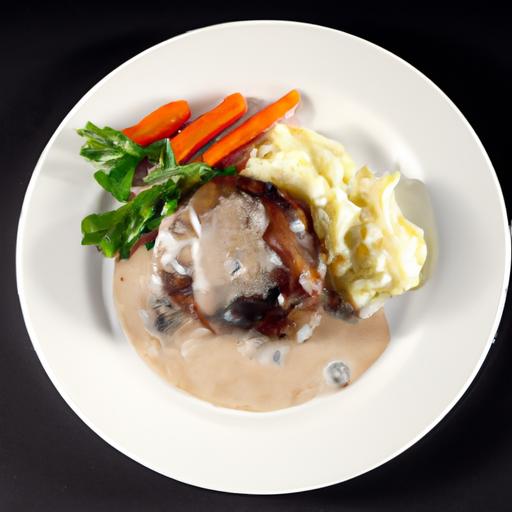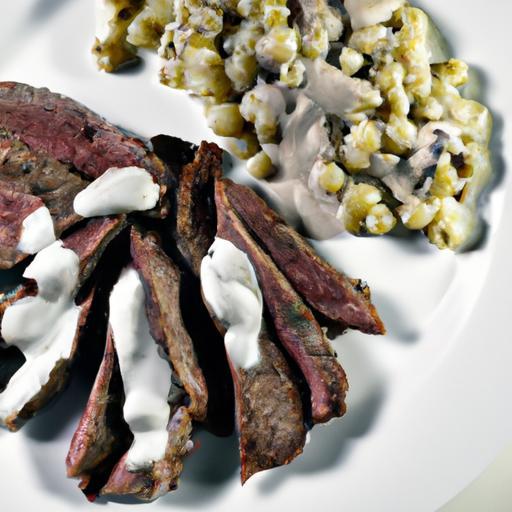In the ever-evolving art of cooking, every ingredient holds a secret weapon, and among these, humble cornstarch emerges as an unexpected hero. More than just a thickening agent, cornstarch possesses a magical ability to transform meat, creating a tender, juicy shield that locks in flavor and moisture like no other. This alchemy of texture and taste is nothing short of culinary sorcery-welcome to the world of “Cornstarch Magic: Unlocking Meat’s Tender Shield.” Here, we delve into the science and technique behind this simple starch’s remarkable power, unlocking the secrets to perfectly tender meat that melts in your mouth and elevates every dish to new heights. Whether you’re a kitchen novice or a seasoned chef, prepare to discover how a sprinkle of cornstarch can revolutionize your cooking game.
Cornstarch Magic breathes life into your cooking technique by transforming even the toughest cuts of meat into succulent, tender bites that melt in your mouth. This method, rooted in centuries of Asian culinary tradition, showcases the simple science behind cornstarch’s unique ability to create a protective shield-locking in moisture and flavors while ensuring a luscious texture every time.
Prep and Cook Time
- Preparation: 15 minutes
- Cooking: 10-15 minutes
- Total Time: 25-30 minutes
Yield
Serves 4 generous portions
Difficulty Level
Medium – Perfect for home cooks looking to elevate their meat dishes with precision and technique
Ingredients
- 1 lb boneless chicken thighs or beef strips, sliced thinly against the grain
- 3 tbsp cornstarch, preferably sifted for an even coating
- 2 tbsp soy sauce (or tamari for gluten-free)
- 1 tbsp Shaoxing wine or dry sherry
- 1 tsp sesame oil
- 1 tbsp grated fresh ginger
- 2 cloves garlic, minced
- 1/2 tsp white pepper
- 1/4 cup water or chicken broth
- 1 tbsp vegetable oil for cooking
- Optional: 1 tsp sugar to balance flavors
Instructions
- Marinate the Meat: In a mixing bowl, combine soy sauce, Shaoxing wine, sesame oil, grated ginger, minced garlic, and white pepper. Add the meat and toss thoroughly to coat. Let it rest for at least 10 minutes to absorb the flavors deeply.
- Dry the Meat: Using a paper towel, gently pat the meat to remove excess marinade surface moisture. This step ensures the cornstarch adheres perfectly.
- Coat the Meat with Cornstarch: Place the 3 tablespoons of cornstarch in a shallow bowl. Add the meat in small batches, turning to coat evenly. Lightly shake off any excess cornstarch. This thin veil acts as the tenderizing shield and prevents moisture loss during cooking.
- Rest the Coated Meat: Let the coated meat sit at room temperature for 5-7 minutes. This brief resting allows the cornstarch to hydrate and bond with meat proteins.
- Heat the Pan: Over medium-high heat, warm the vegetable oil until shimmering but not smoking.
- Sear the Meat: Add the meat in a single layer, avoiding overcrowding. Sauté until the edges turn golden and the internal temperature reaches safe doneness, about 4-6 minutes depending on thickness. Stir occasionally to ensure even coloring without tearing the coating.
- Add Liquid for Juiciness (Optional): Pour in the 1/4 cup water or broth and swirl to deglaze the pan, lifting those flavorful bits. Cover and let the steam gently finish cooking the meat, enhancing tenderness.
- Finish and Serve: Once cooked, remove from heat and let rest briefly to lock juices inside. Serve hot with your favorite sides and garnish.
Tips for Success: Expert Cornstarch Magic
- Combine Cornstarch with Marinades: Start with a flavorful marinade that includes acidic or enzymatic ingredients like ginger and soy sauce. These help break down connective tissue while the cornstarch prevents moisture loss during cooking.
- Ensure Even Application: Use sifted cornstarch to avoid clumps and apply it lightly to prevent a gummy texture. A thin, pristine coating offers the perfect tender shield.
- Control Heat Appropriately: Cooking meat coated in cornstarch at too low a temperature can cause sogginess, while too high a heat risks burning. Medium to medium-high heat is ideal to develop a delicate crust without overcooking.
- Rest for Juiciness: Let your meat rest after coating and after cooking. This two-step resting maximizes moisture retention and texture development.
- Custom Spice Blends: Experiment by adding powders like five-spice, smoked paprika, or chili flakes to the marinade for depth. Cornstarch locks these flavors close to the meat for a burst of savory goodness.
- Make Ahead: Marinate and coat your meat in cornstarch up to 24 hours ahead. Store tightly covered in the fridge and bring to room temperature before cooking.
Serving Suggestions
Present this tender, lustrous meat atop a bed of steamed jasmine rice or nestling with stir-fried seasonal vegetables. Garnish with sliced scallions, toasted sesame seeds, or fresh cilantro to introduce layers of texture and fragrant vibrancy. A drizzle of chili oil or a squeeze of fresh lime can add an exciting finishing touch, elevating the dish’s brightness and complexity.

| Nutrient | Per Serving |
|---|---|
| Calories | 320 |
| Protein | 35g |
| Carbohydrates | 8g |
| Fat | 14g |
For more delightful tips on tenderizing meat and enhancing flavors, explore our Ultimate Marination Guide. You can also deepen your understanding of protein transformations during cooking by visiting ScienceDaily’s Protein Cooking Insights.
Q&A
Q&A: Cornstarch Magic – Unlocking Meat’s Tender Shield
Q1: What is the secret behind cornstarch making meat more tender?
A1: Cornstarch acts like a magical barrier, sealing in the meat’s natural juices. When applied before cooking, it creates a delicate protective coating that keeps moisture locked inside, preventing the meat from drying out and resulting in a tender, juicy bite.
Q2: How does cornstarch interact with meat on a molecular level?
A2: When combined with heat, cornstarch gelatinizes-its starch molecules absorb water and swell, forming a thin, semi-transparent shield. This shield slows down moisture loss and reduces the toughening effect of heat on muscle fibers, effectively softening the meat’s texture.
Q3: Is cornstarch tenderizing the meat chemically, or just protecting it physically?
A3: It’s mostly a physical transformation. Unlike acidic marinades that chemically break down proteins, cornstarch is more like a gentle armor, holding the moisture in and allowing the meat’s natural tenderness to shine through without compromising its structure.
Q4: Can cornstarch be used with all types of meat?
A4: Absolutely! From chicken and pork to beef and even game meats, cornstarch works beautifully. It’s especially popular in Asian cooking, where quick stir-fries benefit from that silky, tender bite that cornstarch helps deliver.
Q5: How do you apply cornstarch to meat for best results?
A5: The key is to coat the meat evenly with a light dusting of cornstarch-often mixed with a splash of soy sauce or egg white for a sticky, clingy texture. Let it rest briefly before cooking to allow the magic barrier to form and lock in juices once heat hits.
Q6: Are there any culinary myths about using cornstarch on meat?
A6: Some believe cornstarch makes meat soggy or slimy, but when used in the right amount and cooked properly, it crisps up or forms a smooth texture that’s far from unpleasant-it’s all about balance and timing!
Q7: Can cornstarch replace traditional tenderizers like marinades or meat mallets?
A7: Cornstarch isn’t a one-stop tenderizing solution but rather a clever complement. It doesn’t break down tough fibers like enzymes or acid-based marinades, but it enhances tenderness by preserving moisture and texture during cooking.
Q8: What culinary styles most famously use cornstarch to tenderize meat?
A8: Chinese stir-fries are the hallmark of cornstarch tenderizing wizardry. The technique, known as velveting, results in meat that’s silky smooth, almost floating in a flavorful sauce – a shining example of cornstarch’s tender shield in action.
Let cornstarch unlock a new level of succulence and tenderness in your next meat dish-it’s simple kitchen sorcery with delicious results!
Closing Remarks
As we unravel the secrets behind cornstarch’s tenderizing magic, it becomes clear that this humble pantry staple is more than just a thickening agent-it’s meat’s secret shield. By creating a delicate barrier that locks in juices and softens fibers, cornstarch transforms ordinary cuts into succulent, melt-in-your-mouth masterpieces. Whether you’re a seasoned chef or a home cook experimenting with culinary alchemy, embracing cornstarch’s subtle power invites a new level of tenderness to every bite. So next time you prepare your favorite meat dish, remember: sometimes, the softest touch comes from the simplest ingredient. Unlock the magic, and savor the difference.


